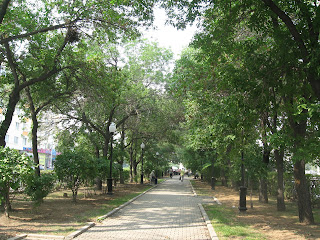
At the health hotel we had Diet No. 5. Pictured here is a typical breakfast.
A Russian breakfast may be similar to supper. You'll notice a cup of tea, a tomato and cucumber salad, an omelet and mashed potatoes. (A Russian omelet is made with lots of milk and is therefore almost a custard.)
Side dishes include tvoroznik (a baked pudding with farmer's cheese), a small plate of oatmeal, a pastry, and red caviar for buttered bread. We could have had boiled chicken or a meat cutlet instead of the omelet. In any case, you can see that there was plenty of food to last us until dinner -- which is in the middle of the day.
A Russian dinner starts with zakuski, or appetizers, which often include vegetable or meat salads. There's also kielbasa, cheese, bread, and a soup course. The main course here will be boiled meat or chicken or baked fish, served on a small plate with mashed potatoes.
The dinner drink at the health hotel is always either kompote, a sweetened beverage made with a few berries or softened dried fruit, or kisel, which tastes somewhat like liquid Jello.
Supper is similar to breakfast. At the health hotel we usually get something to take back to our rooms for a late night snack. Fresh fruit, perhaps. Or kefir to drink (look for kefir in the dairy section of your grocery store; it's similar to buttermilk or drinkable yogurt.)
Diet No. 5 is a generic one here, probably what most people get. There are to be no fried foods. Meat is boiled, braised, or baked. Soups are made with vegetarian broth. Nobody gets seconds, although each portion is small.
One day a tablemate of ours ate our servings of the first course before we arrived. The waitress was indignant, for she had to replace our setting. The guy never tried that trick again!
Slava is a big eater, although a careful one. He needs to have a large stash of fruit around for snacking. So some afternoons we went foraging. From an Armenian couple on the street we bought some grapes and a watermelon. At the central market Slava got plums and peaches. He got pears from a wild orchard we found on a hike.
There's one important food group virtually missing from Diet No. 5. That is coffee. On our first day I asked about coffee at breakfast, and was told that I could have it the next day, which was Tuesday. The next morning I got one packet of instant cafe-au-lait with sugar. I got another one the following Tuesday. I learned that coffee was served only on Tuesdays.
Fortunately I had come prepared for such a situation. I had packed a bag of ground coffee with single cup filters. In a land of tea drinkers, I knew that I might have to be responsible for my own welfare.
Do clients lose weight on Diet No. 5? Not likely. I'll have some remedial work to do in the United States.






















